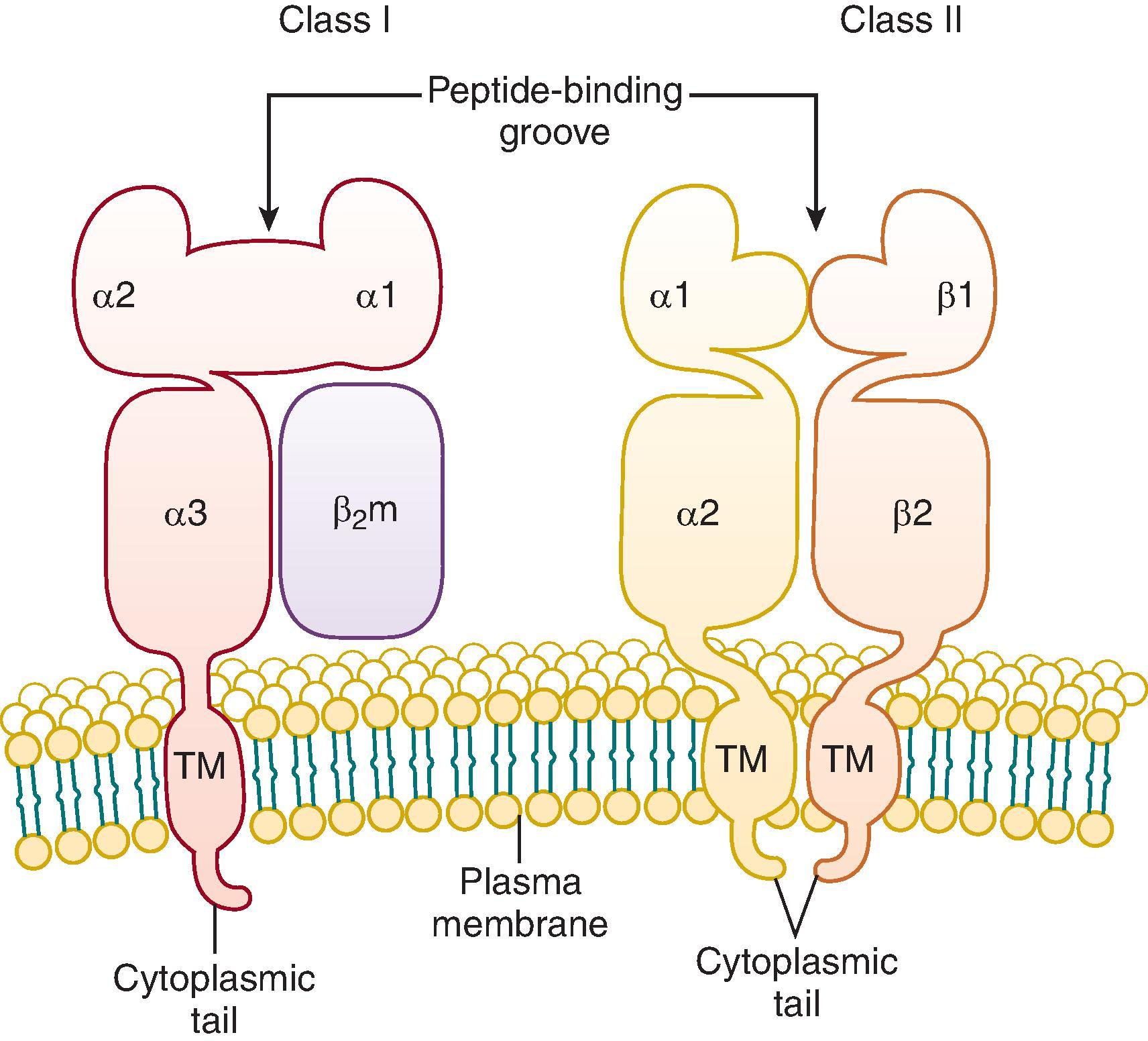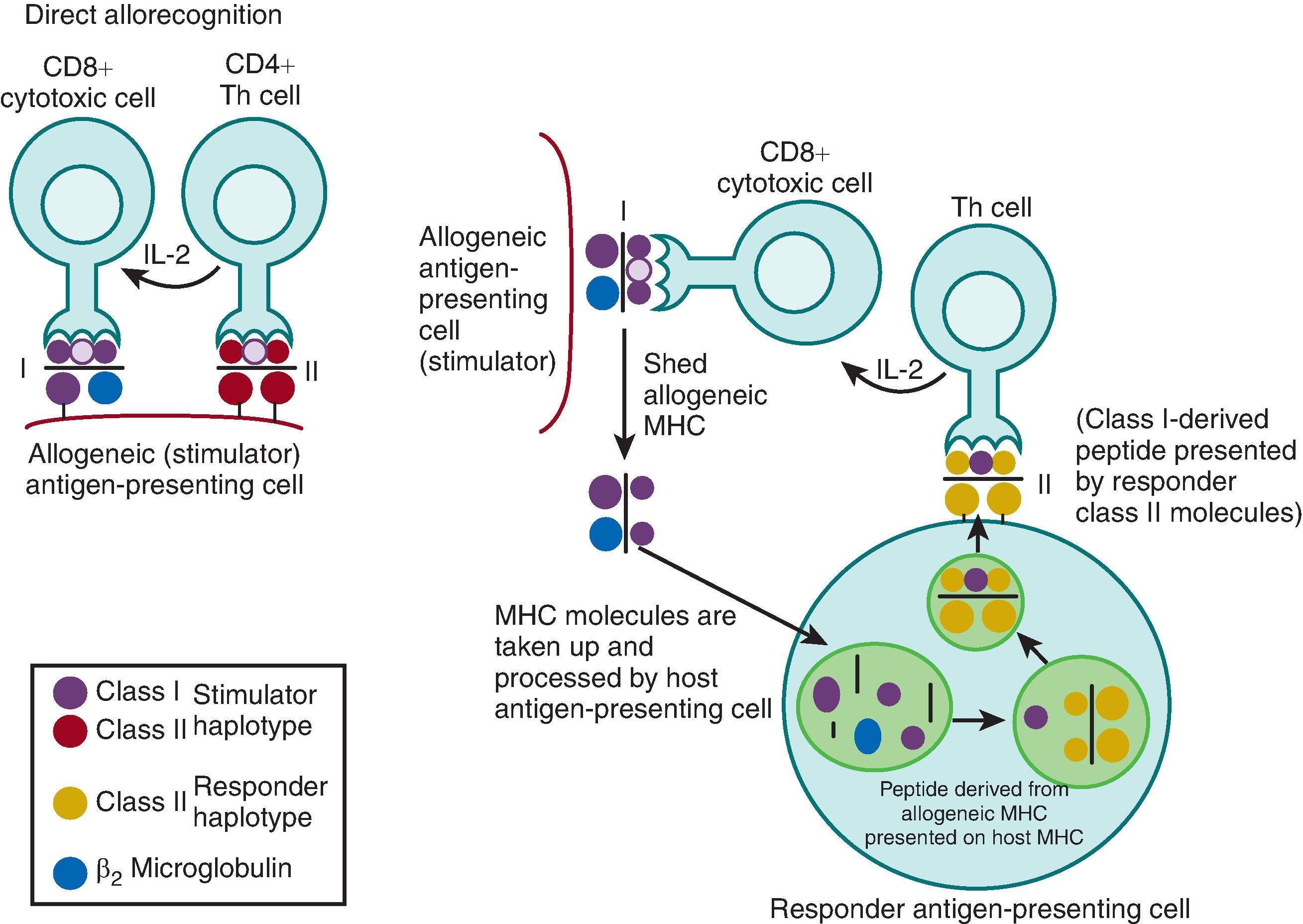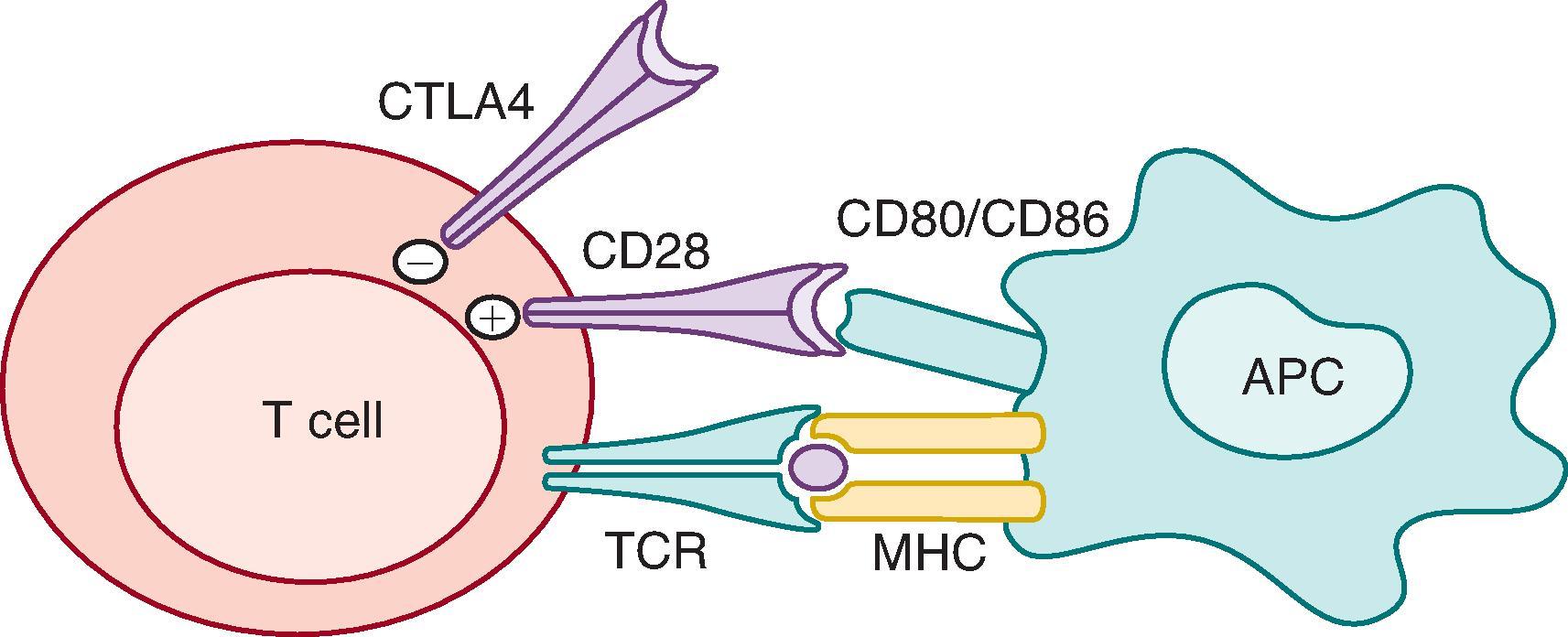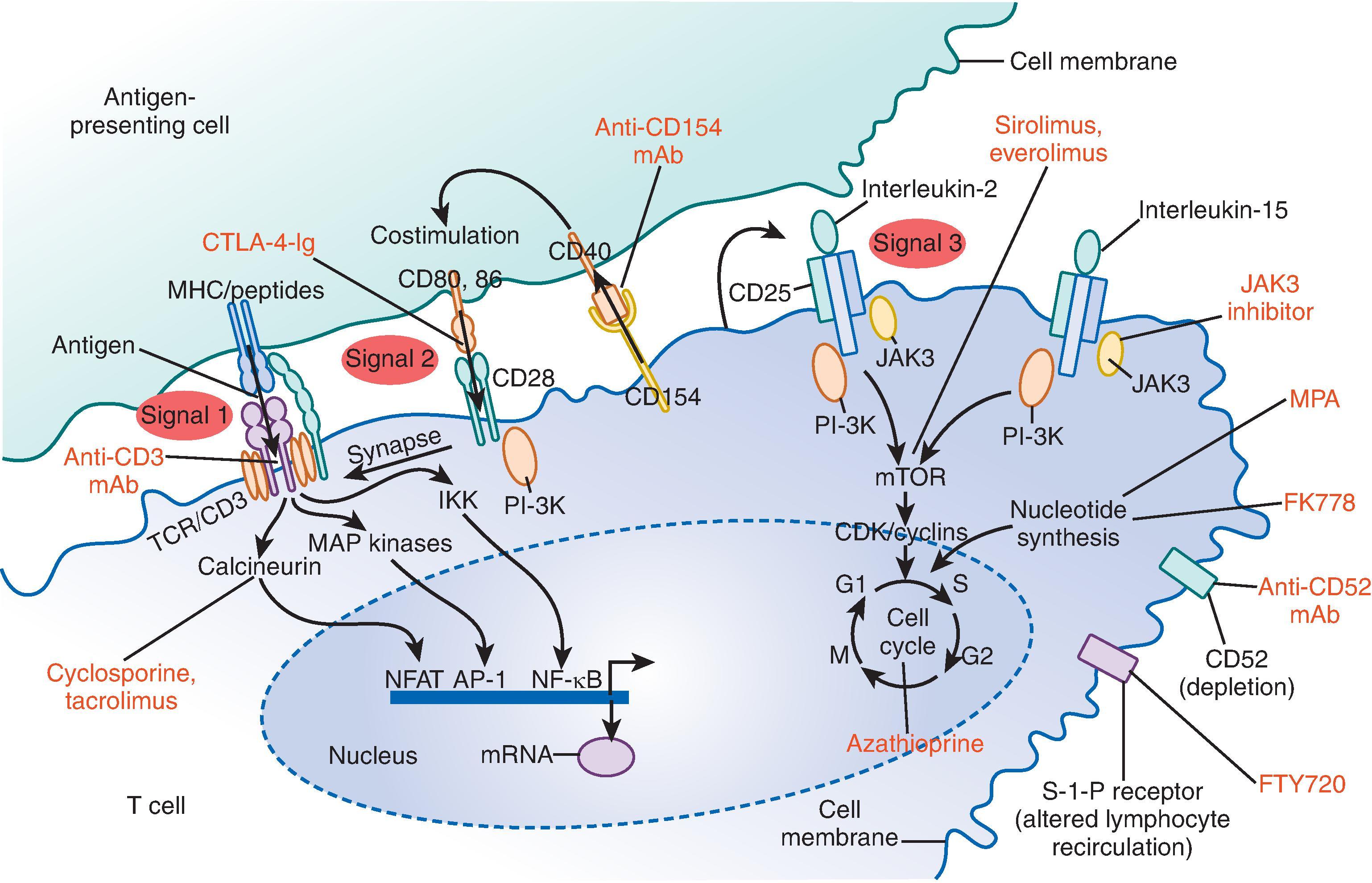Physical Address
304 North Cardinal St.
Dorchester Center, MA 02124
The central issue in organ transplantation remains the prevention of allograft rejection. Understanding the physiology of the immune response to a transplanted organ, developing targeted immunosuppressive drugs, and devising the best combinations to maintain safety and improve efficacy are key for successful graft function and long-term graft survival.
The immune system evolved to discriminate self from non-self, and this response against non-self consists of an array of receptor-mediated sensing and effector mechanisms broadly described as innate and adaptive. Innate immunity is primitive, does not require priming, and is of relatively low affinity but broadly reactive. Adaptive immunity is antigen-specific, depends on antigen exposure or priming, and can be of very high affinity. The major effectors of innate immunity are complement, granulocytes, monocytes/macrophages, natural killer (NK) cells, mast cells, and basophils. The major effectors of adaptive immunity are B and T lymphocytes.
A transplant between genetically distinct individuals of the same species is called an allogeneic graft, or an allograft . The immune response to an allograft requires three elements: recognition of foreign antigens, activation of antigen-specific lymphocytes, and the effector phase of graft rejection. The recognition of antigens as peptide fragments bound to major histocompatibility complex (MHC) molecules, known as human leukocyte antigens (HLAs), is the central event in the initiation of an alloresponse. HLA molecules ( Fig. 61.1 ) are highly polymorphic, follow Mendelian codominant inheritance, and constitute the principal antigenic barrier to transplantation. The degree of HLA matching between the donor and the recipient has been long recognized to play an important role in graft survival, and HLA matching has been incorporated into kidney allocation. More recently, mismatched “eplets,” or patches of polymorphic residues within a radius of 3.0–3.5 Å, which form essential components of HLA epitopes recognized by antibodies, have been found to be a significant risk factor for the development of de novo donor-specific antibody, chronic humoral rejection, and graft loss. In addition, non-HLA molecules, such as MHC class I–related chain A (MICA), are recognized as playing a significant role in rejection, particularly in recipients of well–HLA-matched kidneys.

There are two types of HLA molecules: class I and class II. Class I HLA molecules are expressed on all nucleated cells, whereas class II molecules are usually expressed only on antigen-presenting cells (APCs), which include dendritic cells, B lymphocytes, and macrophages. Cytokines such as interferon-γ (IFN-γ) induce, upregulate, and broaden HLA expression, so that all cells in a graft can become potential targets of the immune response. Ischemia-reperfusion injury in the graft leads to the production of inflammatory cytokines and recruitment of macrophages, and acute rejection episodes are more common in grafts with prolonged ischemia times. Recipient T cells may respond directly to peptides/HLA complexes presented by donor APCs in the graft or to donor HLA peptides presented on the recipient’s own APCs ( Fig. 61.2 ). Acute rejection of an allograft is believed to be primarily dependent on direct allorecognition, whereas the indirect pathway may play a larger role in chronic rejection.

T cells are critically important in the rejection of allogeneic grafts. CD4 T cells (helper T cells) are thought to mediate the initial recognition of an allograft as well as amplify and coordinate the subsequent immune response, including providing help to CD8 (effector) T cells. T cell recognition of the alloantigen occurs via binding of the T cell receptor (TCR)/CD3 complex on the T cell’s surface to the peptide/MHC complex on APCs. This is referred to as signal 1 and leads to phosphorylation of TCR-associated proteins and downstream activation of several pathways, including calcineurin, protein kinase C, and mitogen-activated protein (MAP) kinase pathways. The calcineurin pathway is the most well characterized, and it involves the activation of calcineurin (a phosphatase) by an increase in cytosolic calcium. Calcineurin dephosphorylates nuclear factor of activated T cells (NFAT), allowing NFAT to translocate from the cytoplasm to the nucleus. The NFAT binds to regulatory sequences and increases gene transcription of several cytokines, including interleukin (IL)-2, a T cell growth factor, as well as IL-4, IFN-γ, and tumor necrosis factor-α (TNF-α).
Although the specificity of the immune response is determined by signal 1 , a costimulatory signal, signal 2, which occurs though accessory molecules, is essential for T cell activation. The most potent of these signals regulating T cell clonal expansion and differentiation is provided by the B7/CD28 family of molecules ( Fig. 61.3 ). B7-1 (CD80) and B7-2 (CD86) are ligands on APCs that bind to CD28, expressed on most T cells. Engagement of CD28 increases the production of IL-2 and other cytokines, resulting in T cell proliferation. CD80 and CD86 also regulate T cells by binding another antigen on T cells called cytotoxic T-lymphocyte antigen-4 (CTLA-4) , which inhibits T cell proliferation. A costimulatory interaction between CD40 on APCs and CD40 ligand (CD154, CD40L) on T cells is also critical for activation of APCs and upregulation of B7 expression on T cells. One way to induce T cell anergy in vitro is to provide the T cell with an antigen-specific signal through the TCR (signal 1) in the absence of CD28 engagement (signal 2). However, in most in vivo models of B7 blockade, anergy has been difficult to demonstrate, which is possibly due to the complexity of costimulation that involves multiple stimulatory and inhibitory signals.

Antigen-specific activation of T cells, particularly CD4 T cells, leads to the production of cytokines, the recruitment of monocytes, and the proliferation of CD8 T cells, NK cells, and B cells. CD8 T cells cause cell death in the graft through the release of soluble cytotoxic factors (granzymes and perforin) as well as upregulated Fas ligand on T cells that bind to Fas (CD95) on target cells and trigger apoptosis.
In addition to T cells, B cells and the humoral arm of the immune system play a major role in acute and chronic graft injury. Antibodies produced by the differentiation of B cells into plasma cells cause cell injury through complement fixation or antibody-dependent cellular cytotoxicity. Hyperacute rejection occurs when preformed recipient antibodies to donor HLA antigens or ABO blood group antigens result in complement activation, intravascular coagulation, and graft necrosis within 24 hours of transplantation. Although cross matching and ABO blood typing have virtually eliminated hyperacute rejection, B cells and plasma cells continue to play an important role in subsequent antibody-mediated rejection (AMR) and may be important mediators of chronic graft injury and late graft loss.
The first attempts at immunosuppression used total-body irradiation. Azathioprine was introduced in the early 1960s, and soon thereafter was routinely accompanied by prednisolone in an immunosuppressive regimen. The polyclonal antilymphocyte antibody preparations became available in the mid-1970s. The introduction of cyclosporine in the early 1980s dramatically improved 1-year graft survival rates from 50% to over 80%, and in 1985, OKT3, a monoclonal antibody to CD3, was introduced for the treatment of acute rejection. In the 1990s, tacrolimus and mycophenolate mofetil (MMF) emerged as alternatives to cyclosporine and azathioprine, anti–IL-2 receptor antibodies were approved for induction, and sirolimus became available. Everolimus was approved in 2010 for use in kidney transplant recipients in combination with calcineurin inhibitors. In 2011, belatacept was approved as the first biologic agent for use in maintenance immunotherapy. Commonly used immunosuppressants and their mechanisms of action are listed in Table 61.1 .
| Drug | Phase of Use | Mechanism of Action | Side Effects |
| Glucocorticoids: methylprednisolone (Solu-Medrol), prednisone (Deltasone) | Induction and maintenance | Binds cytosolic receptors and heat shock proteins, and blocks transcription of IL-1, IL-2, IL-3, IL-6, TNF-α, and IFN-γ | Hypertension, hyperglycemia, dyslipidemia, osteoporosis, impaired wound healing, cosmetic effects |
| Calcineurin inhibitors: cyclosporine (Sandimmune, Neoral, Gengraf), tacrolimus (Prograf) | Maintenance | Forms a complex with cyclophilin or FK-binding protein, which binds to calcineurin, preventing dephosphorylation of regulatory proteins and decreasing transcription of IL-2, IL-4, IFN-γ, and TNF-α; also increases TGF-β, which inhibits IL-2 | Tremor, nephrotoxicity, hypertension, hyperglycemia, hyperuricemia, hyperlipidemia (CsA), hirsutism (CsA), gingival hyperplasia (CsA), hair loss (tacrolimus) |
| Antiproliferative Agents | |||
| Azathioprine (Imuran, Azasan) | Maintenance | Purine analog that blocks DNA, RNA, and protein synthesis | Marrow suppression, pancreatitis |
| Mycophenolate mofetil (Cellcept), mycophenolic acid (Myfortic) | Maintenance | Inhibits IMPDH, preventing de novo guanosine nucleotide synthesis | Diarrhea, marrow suppression, teratogenic |
| mTOR inhibitors: sirolimus (Rapamune), everolimus (Zortress) | Maintenance | Forms a complex with FK-binding protein-12, which blocks p70 S6 kinase, causing G1 cell cycle arrest | Hyperlipidemia, hyperglycemia, thrombocytopenia, impaired wound healing, interstitial pneumonitis, embryotoxic |
| Biologics | |||
| Basiliximab (Simulect) | Induction | Monoclonal antibody to CD25 (IL-2 receptor α chain), which blocks IL-2 engagement | Rare infusion reactions |
| Rabbit antithymocyte globulin (Thymoglobulin) | Induction | Polyclonal antithymocyte antibody, which depletes T cells | Cytokine release syndrome, serum sickness, thrombocytopenia, prolonged lymphopenia |
| Alemtuzumab (Campath) | Induction | Monoclonal antibody to CD52, which depletes T cells, B cells, and NK cells | Cytokine release syndrome, prolonged lymphopenia |
| Belatacept (Nulojix) | Maintenance | CTLA-4-Ig fusion protein, which competes with CD28 for CD80/86 binding, inhibiting T-cell costimulation | Rare infusion reactions |
Transplant immunosuppression is guided by three key principles: (1) multiple agents directed at different molecular targets within the alloimmune response are used simultaneously to maximize synergy and efficacy while minimizing toxicity; (2) greater immunosuppression (induction) is needed for early engraftment or to treat established rejection rather than for long-term graft maintenance; and (3) continuous vigilance is essential to identify rejection, drug toxicity, and infection so that the immunosuppressive regimen can be modified appropriately.
T cells have historically been the major target of immunosuppression. The three-signal model of T cell activation and subsequent cellular proliferation provides a useful guide to the sites of action of the major immunosuppressive agents ( Fig. 61.4 ). Signal 1 is the antigen-specific signal provided by the interaction of the MHC/peptide complex on APCs with the TCR/CD3 complex. Signal 2 is a non-antigen-specific costimulatory signal provided by the engagement of B7 on APCs with CD28 on the T cell. These two signals activate intracellular pathways, leading to the production of IL-2 and other cytokines. Stimulation of the IL-2 receptor (CD25) leads to activation of mammalian target of rapamycin (mTOR), a protein kinase, and provides signal 3, which triggers cell proliferation. Therapies targeting antibody-mediated injury are directed against B cells, plasma cells, and complement activation. In general, all drugs in current clinical use have been more effective at suppressing primary rather than memory immune responses.

High intravenous doses of corticosteroids are used as part of nearly all induction immunosuppression protocols. Induction therapy with antibodies is used to delay the use of nephrotoxic calcineurin inhibitors (CNIs) and/or to intensify the initial immunosuppressive therapy in patients at high immunologic risk (i.e., broadly sensitized, high immunologic risk, children, or individuals with a prior transplant). Antibody induction is currently used in over 90% of kidney transplant recipients and consists of either T cell-depleting agents or IL-2 receptor antagonists.
Depleting agents diminish the recipient’s lymphocyte population at the time of transplantation, and induction with these agents has been shown to improve graft survival. Antithymocyte globulin (ATG), a polyclonal antilymphocyte preparation directed against T cells, is the most common induction agent in kidney transplantation and was approved for this indication in 2017. It is interesting to note that ATG also causes sustained and rapid expansion of regulatory T cells, which play an important part in maintaining immune homeostasis and limiting antigraft immunity. The approved dose of rabbit-derived thymoglobulin is 1.5 mg/kg daily for 4 to 7 days. Alemtuzumab (Campath-1H; Sanofi Genzyme) is a humanized anti-CD52 monoclonal antibody that targets lymphocytes, monocytes, macrophages, and NK cells and causes prolonged B and T cell depletion. Alemtuzumab is also used off-label as induction therapy in about 10% of kidney transplants, particularly as part of steroid-sparing protocols. It is usually given as a single dose of 30 mg intraoperatively when infusion-related events are often masked by general anesthesia. Campath-1H was withdrawn from markets in the US and Europe in 2012 to prevent off-label use in multiple sclerosis, but can be obtained directly from the manufacturer by institutions that have established inventory for solid organ transplant induction. ATGAM, an equine ATG, is rarely used in the United States because of its poorer efficacy. Muronomab-CD3 (Orthoclone OKT3; Janssen-Cilag), a murine monoclonal antibody to CD3, was associated with significant acute side effects, such as cytokine release syndrome, and was withdrawn from the market in 2010.
Depleting agents can elicit major side effects, including fever, chills, and hypotension. The polyclonal agents are xenogeneic proteins. Cell death and cytokine release peak with the first infusion and diminish substantially with subsequent doses. Reactions can be minimized by premedication with corticosteroids, acetaminophen, and an antihistamine along with slow infusion (over 4 to 6 hours) through a large-diameter vessel. Other side effects include leukopenia, thrombocytopenia, serum sickness, glomerulonephritis, and, rarely, anaphylaxis. In the long term, depleting agents have been associated with a higher incidence of infections and malignancy, particularly posttransplant lymphoproliferative disorders (PTLDs).
IL-2 receptor antagonists do not deplete T cells, with the possible exception of T regulatory cells; rather, they block IL-2–mediated T cell activation. Daclizumab (Zenapax) and basiliximab (Simulect) are chimeric and humanized monoclonal antibodies, respectively, that bind to the α chain of the IL-2 receptor, thus blocking IL-2–mediated responses. Daclizumab has a longer half-life (T 1/2 ) than basiliximab (20 days vs. 7 days), and the typical dosing schedule results in longer saturation of the IL-2Rα on circulating T cells (120 days vs. 30 to 45 days). However, saturation of the IL-2Rα may not prevent rejection and was noted to be similar in patients with or without an acute rejection episode. Rejection in patients despite IL-2R blockade may occur through a mechanism that bypasses the IL-2 pathway as a result of cytokine-cytokine receptor redundancy (i.e., IL-7, IL-15). Both drugs are fairly well tolerated, and no cytokine release syndrome has been observed, although anaphylaxis may occur rarely. Following the withdrawal of daclizumab from the market in October 2008, basiliximab is the only anti-IL2R antibody currently available for use as induction therapy.
More aggressive approaches to induction therapy have been used in patients with high levels of anti-HLA antibodies, donor-specific antibodies, or previous humoral rejection. These include plasmapheresis and intravenous immune globulin (IVIG), to reduce the levels of preformed antibodies, and rituximab, a chimeric anti-CD20 monoclonal antibody, to selectively deplete B cells.
The basic immunosuppressive protocols use multiple drugs simultaneously. Therapy typically involves a CNI, glucocorticoids, and MMF, each directed at a discrete site in T cell activation. Protocols using rapid steroid withdrawal (within 1 week) are used in over one-third of kidney transplant recipients with good short-term results, although the effects on long-term graft function are not known. Azathioprine has mostly fallen out of favor, except for use during pregnancy and sometimes as part of lower-cost regimens. Sirolimus and everolimus have been used mostly in de novo or conversion regimens that spare/minimize CNI exposure. Maintenance biologic therapy with belatacept, in combination with a steroid and an antiproliferative agent, permits complete avoidance of calcineurin inhibition and has been associated with superior kidney function, improved metabolic parameters, and improved graft survival in recipients at low immunologic risk.
Become a Clinical Tree membership for Full access and enjoy Unlimited articles
If you are a member. Log in here